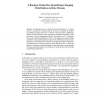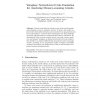194 search results - page 20 / 39 » Behavioral Distance for Intrusion Detection |
PKDD
2005
Springer
14 years 1 months ago
2005
Springer
In applications such as fraud and intrusion detection, it is of great interest to measure the evolving trends in the data. We consider the problem of quantifying changes between tw...
KDD
2004
ACM
14 years 8 months ago
2004
ACM
We present and empirically analyze a machine-learning approach for detecting intrusions on individual computers. Our Winnowbased algorithm continually monitors user and system beh...
INFOCOM
2006
IEEE
14 years 1 months ago
2006
IEEE
— Polymorphic worms can change their byte sequence as they replicate and propagate, thwarting the traditional signature analysis techniques used by many intrusion detection syste...
DIMVA
2009
13 years 9 months ago
2009
Remote code-injection attacks are one of the most frequently used attacking vectors in computer security. To detect and analyze injected code (often called shellcode), some researc...
TNC
2004
13 years 9 months ago
2004
The function of a Network Intrusion Detection System (NIDS) is to identify any misuse and abnormal behavior determined as an attack to a network segment or network host. The propo...


